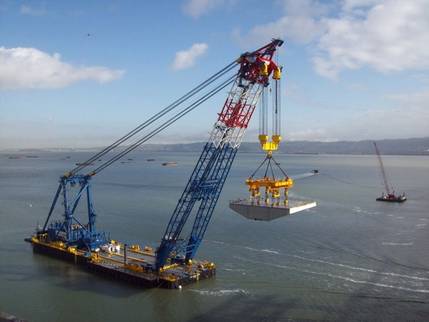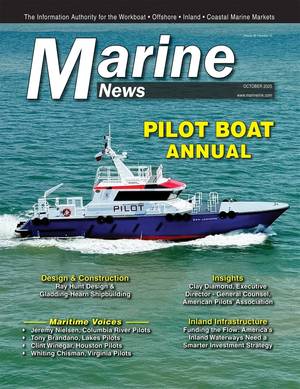Weak Drybulk Market Hurts VLCCF Results
Highlights
- Knightsbridge reports net income of $6.3 million and earnings per share of $0.14 for the second quarter of 2014.
- Knightsbridge reports EBITDA of $10.5 million and EBITDA per share of $0.24 for the second quarter of 2014.
- Knightsbridge receives $3.2 million as partial settlement for a claim for damages and unpaid charter hire.
- Knightsbridge announces a cash distribution of $0.20 per share for the second quarter of 2014.
- Knightsbridge completes the purchase of five Capesize newbuilding contracts and one 2013-built Capesize drybulk carrier from Frontline 2012 Ltd and Hemen Holdings Ltd, respectively.
- Knightsbridge announces the combination of Frontline 2012's remaining fleet of 25 fuel efficient Capesize newbuildings with Knightsbridge's fleet.
- Knightsbridge entered into a $420 million term loan facility in June 2014 to part finance the company's newbuilding program.
Second Quarter 2014 and Six Months Results
The company reports net income of $6.3 million and earnings per share of $0.14 for the second quarter compared with net income of $10.7 million and earnings per share of $0.35 for the preceding quarter. Net income in the second quarter and first quarter includes receipts of $3.2 million and $9.7 million, respectively, as partial settlements for a claim for damages and unpaid charter hire. Net income in the second quarter also includes a receipt of $2.6 million upon the early termination of the time charter of the Belgravia. The average daily time charter equivalent (TCE) earned by the Capesize vessels in the second quarter was $15,000 compared with $25,200 in the preceding quarter. In August 2014, the company estimates an average cash cost breakeven rate for the remainder of 2014 on a TCE basis for its Capesize vessels of $13,000 per vessel per day.
Cash and cash equivalents decreased by $89.3 million in the second quarter. The company generated cash from operating activities of $1 million, paid $24.1 million for the purchase of the Bulk China (including bunkers and Lubes), paid $129.7 million in respect of its newbuilding program, received $43.4 million in connection with the purchase of five SPCs from Frontline 2012 Ltd, paid $9.8 million to shareholders and borrowed $29.9 million from the banks (net of fees paid). The company expects to draw down $90 million from the $420 million term loan facility in the third quarter of 2014 in connection with the three newbuildings delivered in the second quarter.
For the six months ended June 30, 2014, the company reports net income of $17 million and earnings per share of $0.45 compared with a net loss of $7.9 million and a loss per share of $0.32 in the six months ended June 30, 2013. The net loss in the six months ended June 30, 2013 includes a net loss from discontinued operations of $6.9 million. The average daily TCE earned by the Capesize vessels in the six months ended June 30, 2014 is $20,400 compared with $17,400 in the six months ended June 30, 2013.
Fleet Development
On April 23, 2014, the company acquired five special purpose companies (SPCs) from Frontline 2012 Ltd, each owning a fuel efficient 180,000 dwt Capesize bulk carrier newbuilding, and one 2013-built Capesize bulk carrier from Hemen Holdings Ltd for a total consideration of $360 million of which $186 million was paid in shares based on a price of $10.00 per share, $150 million in absorption of remaining newbuilding instalments and $24 million in cash. The company issued 15.5 million shares to Frontline 2012 and 3.1 million shares to Hemen on April 23 at $12.54 per share, being the closing price per share on that date.
The company took delivery of the 2013-built Capesize bulk carrier on April 23. Four of the Capesize newbuildings have been delivered to date - KSL Seattle on May 14, KSL Singapore on May 19, KSL Sapporo on June 20, and KSL Sydney on July 30. The final newbuilding is expected to be delivered in September 2014.
The company's sailing fleet currently consists of nine Capesize bulk carriers employed in the spot market or on index related time charter contracts.
The company's newbuilding program will consist of 30 Capesize bulk carriers with estimated delivery in 2014-2016, of which 25 will be purchased from Frontline 2012.
Corporate
On April 24, 2014 Knightsbridge announced it had agreed to combine Frontline 2012's remaining fleet of 25 fuel efficient vessels with Knightsbridge. Under the agreement in principle, the exchange ratio for the acquisition and share issuance will be based on NAV using March 31, 2014 broker values. The Knightsbridge/Frontline 2012 exchange ratio will be 44%/56%. Accordingly, Knightsbridge has agreed to issue 62 million shares to Frontline 2012 and absorb $894 million in net remaining estimated Capex. The closing will be executed in two stages, with 31 million shares expected to be issued around September 15, 2014 and 31 million shares around March 15, 2015. The transaction is subject to definitive documentation, normal closing conditions and regulatory approvals.
In June 2014, the company entered into a $420 million term loan facility with a number of banks to part finance 14 of the company's current and future newbuildings divided into 14 tranches of $30 million each based on a 20 year loan profile. The second hand vessel bought from Hemen is financed by an existing facility and will enjoy an installment holiday until May 2015.
49,121,550 ordinary shares were outstanding as of June 30, 2014, and the weighted average number of shares outstanding for the quarter was 44,420,451. Following the expected issuance of shares in September 2014 and March 2015, the company will have 111.2 million shares outstanding and a market capitalization of $1.3 billion based on the current share price.
In June 2014, the company's authorized share capital was increased from $500,000 divided into 50 million common shares of $0.01 par value each to $2 million divided into 200 million common shares of $0.01 par value each.
The company has called its Annual General Meeting (AGM) of Shareholders to be held on September 19, 2014. The AGM materials are in the process of being distributed to the shareholders.
The board has decided to declare a cash distribution of $0.20 per share. The record date is August 28, 2014, the ex dividend date is August 26, 2014 and the cash distribution will be paid on or around September 10, 2014.
The Drybulk Market
The second quarter took the drybulk industry by surprise. It did not live up to expectations forecast by most analysts following the sector. Capesize vessels earned on average $11,900 per day compared to $16.300 per day the previous quarter, but still almost twice as much as the same quarter in 2013. Positive expectations were also reflected in the forward freight market (FFA) which priced the second quarter at $20,000 per day the last trading days of the previous quarter. Chinese steel production has grown by approximately six percent in the first half of 2014 from the previous six month period, which was in line or even above the consensus forecast. Analysts have also been right in their fleet growth assumptions, so the relatively disappointing fleet utilization has to be explained by other reasons.
Continued weak Chinese coal and bauxite import has meant a plentiful supply of Panamaxes to put pressure on Capesize through ratios in the coal trade. Coal demand from China has been considerably lower than anticipated due to more available hydro power and increased use of natural gas. Chinese imports and production of thermal coal each declined by one percent in the first half of 2014 compared to the first half of 2013. In addition, the ban on exports put in place by the Indonesian Government for nickel ore and bauxite, and a relatively moderate South American grain season did not support the smaller segments which again have a negative impact on Capesizes. China has been drawing down on bauxite and nickel ore inventories for the last six months and unless the ban is lifted sourcing has to take place from longer distances.
Iron ore which is the main demand driver for the Capesize segment has lived up to its expectations. China alone imported 457 million mt in the first half of the year, representing an increase of 19 percent year on year. The three major suppliers in Australia (Rio Tinto, BHP and FMG) have pushed forward their expansion plans and are expected to add another 130 million mt of extra commodity this year. Brazil is also adding capacity and if the country is going reach its target of 350 million mt for 2014 a ramp up has to take place in the second half of 2014. This should support the freight market given the longer sailing distances to Far East. Prices of international ore have been under pressure and should support imports versus domestic Chinese production going forward.
In spite of the recent spot soft market, most forecasters have a positive market outlook. This is in particular valid for the fourth quarter this year and onwards. The same is reflected in the forward freight market (FFA) which at the moment of writing is trading at prices twice the present spot market on average from October 2014 and through 2015. Owners of Capesize vessels are reluctant to commit their vessels on long period time charters unless they obtain rates that are even higher than the present FFA market.
Approximately 11 million dwt of new drybulk capacity was delivered during the second quarter of 2014, compared to 16 million dwt the previous quarter. Scrapping has been fairly stable and four million dwt was removed from the tonnage list last quarter. As a consequence of a softer freight market, ordering of new vessels came down compared to the previous quarter. Available data is showing that orders for 14 million dwt of new capacity were signed during the second quarter of 2014, half of what was reported during the first quarter of 2014. The present order book represents approximately 19 percent of the existing fleet.
After several quarters of steady rise in asset values, prices corrected down. The Capsizes however were holding better up than the smaller segments and according to sale and purchase brokers modern vessels (maximum 5 years old) were priced three percent lower by the end of June compared to end of March 2014.
Outlook
The weak drybulk market in the second quarter has continued into the third quarter. This is obviously disappointing, as the board had expected a recovery by now. The board, however, is still confident that we will see a recovery in the market later this year.
The Frontline 2012 transaction is a transformative step for Knightsbridge. With a unique fleet of 39 modern Capesize vessels, of which 34 are fuel efficient newbuildings expected to achieve higher time charter equivalent earnings than existing vessels in any market situation, and a targeted cash breakeven rate below $15,000 per day, Knightsbridge is in a strong position to benefit from an expected recovery in the drybulk market.
The board will seek to grow the company's dividend per share as the drybulk market recovers and newbuildings commence operation. Further growth and consolidation opportunities are currently being evaluated.












